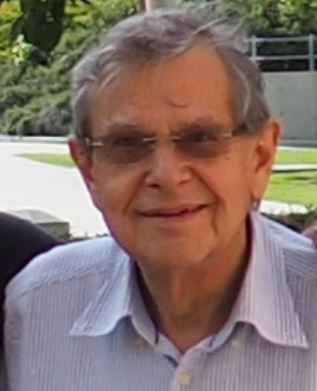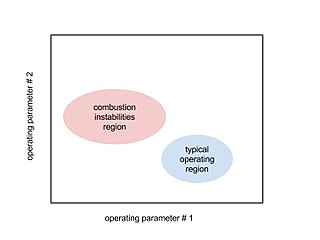
Combustion, or burning, is a high-temperature exothermic redox chemical reaction between a fuel and an oxidant, usually atmospheric oxygen, that produces oxidized, often gaseous products, in a mixture termed as smoke. Combustion does not always result in fire, because a flame is only visible when substances undergoing combustion vaporize, but when it does, a flame is a characteristic indicator of the reaction. While activation energy must be supplied to initiate combustion, the heat from a flame may provide enough energy to make the reaction self-sustaining. The study of combustion is known as combustion science.

In physics, physical chemistry and engineering, fluid dynamics is a subdiscipline of fluid mechanics that describes the flow of fluids – liquids and gases. It has several subdisciplines, including aerodynamics and hydrodynamics. Fluid dynamics has a wide range of applications, including calculating forces and moments on aircraft, determining the mass flow rate of petroleum through pipelines, predicting weather patterns, understanding nebulae in interstellar space and modelling fission weapon detonation.

A premixed flame is a flame formed under certain conditions during the combustion of a premixed charge of fuel and oxidiser. Since the fuel and oxidiser—the key chemical reactants of combustion—are available throughout a homogeneous stoichiometric premixed charge, the combustion process once initiated sustains itself by way of its own heat release. The majority of the chemical transformation in such a combustion process occurs primarily in a thin interfacial region which separates the unburned and the burned gases. The premixed flame interface propagates through the mixture until the entire charge is depleted. The propagation speed of a premixed flame is known as the flame speed which depends on the convection-diffusion-reaction balance within the flame, i.e. on its inner chemical structure. The premixed flame is characterised as laminar or turbulent depending on the velocity distribution in the unburned pre-mixture.
In combustion engineering and explosion studies, the Markstein number characterizes the effect of local heat release of a propagating flame on variations in the surface topology along the flame and the associated local flame front curvature. The dimensionless Markstein number is defined as:
The Sugden Award is an annual award for contributions to combustion research. The prize is awarded by the British Section of The Combustion Institute for the published paper with at least one British Section member as author, which makes the most significant contribution to combustion research. The prize is named after Sir Morris Sugden.
Combustion models for CFD refers to combustion models for computational fluid dynamics. Combustion is defined as a chemical reaction in which a fuel reacts with an oxidant to form products, accompanied with the release of energy in the form of heat. Being the integral part of various engineering applications like: internal combustion engines, aircraft engines, rocket engines, furnaces, and power station combustors, combustion manifests itself as a wide domain during the design, analysis and performance characteristics stages of the above-mentioned applications. With the added complexity of chemical kinetics and achieving reacting flow mixture environment, proper modeling physics has to be incorporated during computational fluid dynamic (CFD) simulations of combustion. Hence the following discussion presents a general outline of the various adequate models incorporated with the Computational fluid dynamic code to model the process of combustion.
Chemical reaction models transform physical knowledge into a mathematical formulation that can be utilized in computational simulation of practical problems in chemical engineering. Computer simulation provides the flexibility to study chemical processes under a wide range of conditions. Modeling of a chemical reaction involves solving conservation equations describing convection, diffusion, and reaction source for each component species.
The laminar flamelet model is a mathematical method for modelling turbulent combustion. The laminar flamelet model is formulated specifically as a model for non-premixed combustion
Multiscale turbulence is a class of turbulent flows in which the chaotic motion of the fluid is forced at different length and/or time scales. This is usually achieved by immersing in a moving fluid a body with a multiscale, often fractal-like, arrangement of length scales. This arrangement of scales can be either passive or active
In combustion, the Karlovitz number is defined as the ratio of chemical time scale to Kolmogorov time scale , named after Béla Karlovitz. The number reads as
Sébastien Candel is a French physicist, Emeritus Professor of École Centrale Paris.

Forman Arthur Williams is an American academic in the field of combustion and aerospace engineering who is Emeritus Professor of Mechanical and Aerospace Engineering at the University of California San Diego.
Paul Andrews Libby was a professor of mechanical and aerospace engineering at the University of California, San Diego, a specialist in the field of combustion and aerospace engineering.

Combustion instabilities are physical phenomena occurring in a reacting flow in which some perturbations, even very small ones, grow and then become large enough to alter the features of the flow in some particular way.
Jacqueline H. Chen is an American mechanical engineer. She works in the Combustion Research Facility of Sandia National Laboratories, where she is a Senior Scientist. Her research applies massively parallel computing to the simulation of turbulent combustion.

David S-K Ting is a Canadian academic, author and researcher. He is a professor of mechanical, automotive & materials engineering at the University of Windsor. He is the founder of the Turbulence & Energy Laboratory.
Aimee Sian Morgans is a British engineer who is Professor of Mechanical Engineering at Imperial College London. Her research considers thermoacoustic instabilities. She was elected Fellow of the Royal Academy of Engineering in 2021.
Bénédicte Cuenot is a French engineer specializing in the numerical simulation of combustion and related phenomena, including turbulent flow, the flow of plasma, and heat transfer. Her software has been used to investigate the emission of pollutants and other products of combustion, non-carbon-based fuels including hydrogen, ammonia, and metal powders, the start and end of combustion, and the ability of combustion chambers to stand up under use. She heads the combustion research group at the European Centre for Research and Advanced Training in Scientific Computation (CERFACS) in Toulouse, and holds a professorship in mechanical engineering at Eindhoven University of Technology in the Netherlands.

Sujith Raman Pillai Indusekharan Nair is an Institute Professor and the D. Srinivasan Chair Professor in the Department of Aerospace Engineering at the Indian Institute of Technology Madras. In 2023, he was inducted as International Member of the United States National Academy of Engineering. He was selected as a Fellow of the Combustion Institute in 2022, and was awarded the Distinguished Fellowship of the International Institute of Acoustics and Vibration in 2021. He received the J. C. Bose Fellowship in 2019 and the Swarnajayanti Fellowship in 2005 from the Department of Science and Technology of the Government of India. He is a Fellow of the Indian Academy of Sciences, an Associate Fellow of the American Institute of Aeronautics and Astronautics, a Fellow of the Indian National Academy of Engineering, and an Honorary Fellow of the Indian Society of Systems for Science and Engineering (ISSE). He has been awarded Hans Fischer Senior Fellowship from the TUM Institute for Advanced Study in 2010. He was awarded Alexander von Humboldt Fellowship in 2000. He was the editor-in-chief of the International Journal of Spray and Combustion Dynamics from 2009 to 2015. He is currently a member of the editorial advisory board member of Chaos: An Interdisciplinary Journal of Nonlinear Science.
The Matalon–Matkowsky–Clavin–Joulin theory refers to a theoretical hydrodynamic model of a premixed flame with a large-amplitude flame wrinkling, developed independently by Moshe Matalon & Bernard J. Matkowsky and Paul Clavin & Guy Joulin, following the pioneering study by Paul Clavin and Forman A. Williams and by Pierre Pelcé and Paul Clavin. The theory, for the first time, calculated the burning rate of the curved flame that differs from the burning rate of the planar flame due to flame stretch, associated with the flame curvature and the strain imposed on the flame by the flow field.






